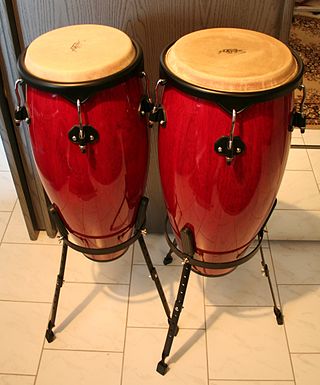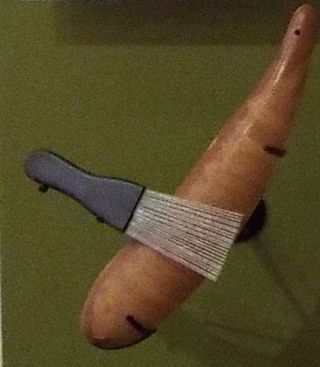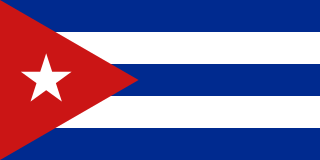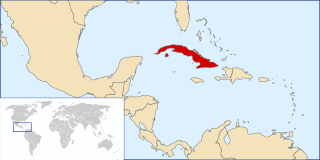This article needs additional citations for verification .(January 2013) |
An abwe or chekeré is a Cuban musical ensemble that uses gourds. [1] It is a product of cabildos, historical congregations of African slaves brought to Cuba. [2]
This article needs additional citations for verification .(January 2013) |
An abwe or chekeré is a Cuban musical ensemble that uses gourds. [1] It is a product of cabildos, historical congregations of African slaves brought to Cuba. [2]

Salsa music is a style of Caribbean music, combining elements of Cuban, Puerto Rican, and American influences. Because most of the basic musical components predate the labeling of salsa, there have been many controversies regarding its origin. Most songs considered as salsa are primarily based on son montuno and son Cubano, with elements of cha-cha-chá, bolero, rumba, mambo, jazz, R&B, rock, bomba, and plena. All of these elements are adapted to fit the basic Son montuno template when performed within the context of salsa.

The güiro is a percussion instrument consisting of an open-ended, hollow gourd with parallel notches cut in one side. It is played by rubbing a stick or tines along the notches to produce a ratchet sound.
Cuban may refer to:
Latin jazz is a genre of jazz with Latin American rhythms. The two main categories are Afro-Cuban jazz, rhythmically based on Cuban popular dance music, with a rhythm section employing ostinato patterns or a clave, and Afro-Brazilian jazz, which includes samba and bossa nova.
Bolero is a genre of song which originated in eastern Cuba in the late 19th century as part of the trova tradition. Unrelated to the older Spanish dance of the same name, bolero is characterized by sophisticated lyrics dealing with love. It has been called the "quintessential Latin American romantic song of the twentieth century".

The marímbula is a plucked box musical instrument of the Caribbean. In Cuba it is common in the changüí genre, as well as old styles of son. In Mexico, where it is known as marimbol is played in son jarocho; in the Dominican Republic, where it is known as marimba, it is played in merengue típico, and in Jamaica it is known as rumba box and played in mento.
Afro-Caribbean music is a broad term for music styles originating in the Caribbean from the African diaspora. These types of music usually have West African/Central African influence because of the presence and history of African people and their descendants living in the Caribbean, as a result of the trans-Atlantic slave trade. These distinctive musical art forms came about from the cultural mingling of African, Indigenous, and European inhabitants. Characteristically, Afro-Caribbean music incorporates components, instruments and influences from a variety of African cultures, as well as Indigenous and European cultures.

Danza is a musical genre that originated in Ponce, a city in southern Puerto Rico. It is a popular turn-of-the-twentieth-century ballroom dance genre slightly similar to the waltz. Both the danza and its cousin the contradanza are sequence dances, performed to a pattern, usually of squares, to music that was instrumental. Neither the contradanza nor the danza were sung genres; this is a contrast to, for example, the habanera, which was a sung genre. There is some dispute as to whether the danza was in any sense a different dance from the contradanza, or whether it was just a simplification of the name. Through the first part of the 19th century the dance and its music became steadily more creolized. The music and the dance is creolized because composers were consciously trying to integrate African and European ideas because many of the people themselves were creoles, that is, born in the Caribbean; accepting their islands as their true and only homeland.
Pachanga is a genre of music which is described as a mixture of son montuno and merengue and has an accompanying signature style of dance. This type of music has a festive, lively style and is marked by jocular, mischievous lyrics. Pachanga originated in Cuba in the 1950s and played an important role in the evolution of Caribbean style music as it is today. Considered a prominent contributor to the eventual rise of salsa, Pachanga itself is an offshoot music played by charangas. Very similar in sound to Cha-Cha but with a notably stronger down-beat, Pachanga once experienced massive popularity all across the Caribbean and was brought to the United States by Cuban immigrants post World War II. This led to an explosion of Pachanga music in Cuban music clubs that influenced Latin culture in the United States for decades to come.

Cuba, officially the Republic of Cuba, is an island country, comprising the island of Cuba, Isla de la Juventud, and 4,195 islands, islets and cays surrounding the main island. It is located where the northern Caribbean Sea, Gulf of Mexico, and Atlantic Ocean meet. Cuba is located east of the Yucatán Peninsula (Mexico), south of both Florida and the Bahamas, west of Hispaniola, and north of Jamaica and the Cayman Islands. Havana is the largest city and capital. Cuba is the third-most populous country in the Caribbean after Haiti and the Dominican Republic, with about 10 million inhabitants. It is the largest country in the Caribbean by area.

The following is an alphabetical list of topics related to Cuba.
Tropical music is a term in the Latin music industry that refers to music genres deriving from or influenced by the Spanish-speaking areas of the Caribbean. It includes the islands of Cuba, Puerto Rico, the Dominican Republic, and the Caribbean coastal regions of Colombia, Mexico, Central America and Venezuela.

The Caribbean is a subregion of the Americas that includes the Caribbean Sea and its islands, some of which are surrounded by the Caribbean Sea and some of which border both the Caribbean Sea and the North Atlantic Ocean; the nearby coastal areas on the mainland are sometimes also included in the region. The region is south-east of the Gulf of Mexico and Northern America, east of Central America, and north of South America.
The term Caribbean culture summarizes the artistic, musical, literary, culinary, political and social elements that are representative of Caribbean people all over the world.

Yellow bird is a Caribbean cocktail.
Kontradans or the French-Haitian Contredanse, is creolized dance music formed in the 18th century in the French colony of Saint-Domingue (Haiti) that evolved from the English contra dance, or, which eventually spread throughout the Caribbean, Louisiana, Europe and the rest of the New World from the Creoles of Saint-Domingue.